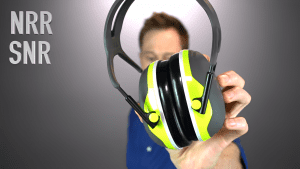Table of Contents
In today’s fast-paced and noise-filled world, the preservation of our hearing has become a paramount concern. To address this issue, ear defenders have emerged as a vital safety apparatus for individuals who require optimal auditory protection. These sophisticated devices are designed to effectively reduce the entry of external sound into the ear, thereby safeguarding our delicate auditory system. Within the realm of hearing protection, ear defenders manifest in diverse forms, boasting an assortment of shapes and sizes to accommodate the specific needs of users.

This comprehensive blog post delves into the intricacies of ear defenders, shedding light on their composition, functionality, and the plethora of options available in the market.
Table of Contents
- Types of Ear Defenders
- Ear Defenders Materials and Construction Detailes
- Three Main Methods to Evaluate Which Ear Defenders Are Right for You
How Do Ear Defenders Work?
Ear defenders function by effectively blocking out noise to protect your hearing. This noise-blocking mechanism operates in two ways: passively and actively. Passive ear defenders create a seal around the ear, preventing sound waves from entering. By forming a physical barrier, they limit the amount of noise that reaches your ears and help safeguard your hearing.
On the other hand, active ear defenders employ advanced electronic technology to actively counteract and cancel out noise. These devices use built-in microphones to capture external sounds and generate anti-noise signals that are fed back into the ear defenders. This active noise cancellation process effectively reduces the intensity of incoming noise, minimizing its impact on your ears.
To ensure the appropriate use of ear defenders, it is important to determine the level of sound around you. This can be achieved by utilizing sound level meters, which measure the pressure of sound waves in decibels. These meters provide valuable readings, such as A-weighted and C-weighted frequency measurements, representing the sound frequencies perceived by the human ear at different ranges.
Sound waves, which are vibrations that travel through the air, are the basis of how we perceive sounds. When an object vibrates, it disturbs the surrounding air particles, causing a chain reaction of particle vibrations. These vibrations, or sound waves, enter our ears and are transmitted to tiny hair-like cells within our inner ear, which then send electrical signals to the brain for sound perception. However, if the vibrations are too intense, these delicate cells can be damaged, resulting in hearing loss. Ear defenders play a crucial role in minimizing the impact of these powerful vibrations and protecting our sensitive hearing cells.
Sound waves consist of various frequencies or pitches, and the amplitude, or height, of the wave determines the loudness of a sound. A higher amplitude corresponds to a louder sound. By reducing the amplitude of incoming sound waves, ear defenders help mitigate the potential harm caused by loud noises and maintain the integrity of our auditory system.
Types of Ear Defenders
Ear defenders play a critical role in safeguarding our hearing by providing a physical barrier against loud noises. These devices are specifically designed to cover the ears, offering protection and reducing the risk of noise-induced hearing damage. By investing in suitable ear defenders and utilizing them in noisy environments, individuals can significantly reduce the risk of noise-induced hearing loss and ensure the long-term preservation of their hearing health.
Passive and Active
There are two primary types of ear defenders: passive and active. Passive ear defenders are built to block out noise by utilizing acoustic materials and physical barriers. They work by attenuating the intensity of sound waves before they reach the ear, effectively reducing the overall noise exposure. These types of ear defenders are commonly used in various industries and activities where noise levels can be high, such as construction sites, manufacturing facilities, shooting ranges, or concerts.

Active ear defenders, on the other hand, incorporate advanced electronic technology to actively cancel out or suppress incoming noise. These devices employ built-in microphones to capture external sounds, and then generate an anti-noise signal that is fed back into the ear defenders. By creating an “anti-noise” wave, active ear defenders can counteract and neutralize specific frequencies of noise, resulting in a more effective and personalized noise reduction experience. This technology is particularly beneficial in environments where constant or unpredictable noise levels are present, such as aviation, military operations, or industrial settings.
Over-ear and In-ear
To cater to individual preferences and requirements, ear defenders are available in a diverse range of options. Over-ear defenders, characterized by their robust design, encompass the entire ear, providing substantial coverage and insulation from external noise sources. They often feature cushioned ear cups and an adjustable headband for a secure and comfortable fit. Over-ear defenders are commonly used in environments where high noise levels persist for extended periods.
In-ear defenders, also known as earplugs, offer a more compact and discreet alternative. They are designed to fit snugly inside the ear canal, forming a seal that effectively blocks out noise. In-ear defenders are highly portable and convenient, making them suitable for situations where discretion or mobility is crucial. They are commonly used in industries such as music, hospitality, and personal use, where a high level of noise reduction is desired while maintaining a low-profile appearance.
The availability of different types and designs of ear defenders allows individuals to select the most appropriate option based on their specific needs, comfort preferences, and the level of noise exposure they anticipate. It is important to consider factors such as noise intensity, duration of exposure, comfort, and compatibility with other personal protective equipment when choosing the right ear defenders.
Ear Defenders Materials and Construction Detailes
Ear defenders are meticulously crafted with attention to materials and construction details to ensure optimal performance and user comfort. Typically, ear defenders consist of three essential components: an ear cup, headband, and padding.
The ear cup, made from a durable and rigid plastic material, plays a vital role as the primary barrier against incoming noise. Its design and construction aim to provide a secure and effective seal around the ear, effectively minimizing the entry of external sound waves.
The headband, typically constructed from a flexible and sturdy material, rests over the top of the head to secure the ear defenders in place. It ensures a snug fit and proper positioning, preventing any unwanted movement or displacement during use. The headband’s material is carefully chosen to strike a balance between durability, flexibility, and wearer comfort.
To enhance comfort and minimize pressure points, padding is incorporated into the ear defenders. The padding, often made from soft and cushioning materials, provides a layer of insulation between the ear cups and the wearer’s head. This helps alleviate discomfort, especially during prolonged periods of use, and ensures a more enjoyable wearing experience
In addition to the core components, ear defenders may also feature special coatings or treatments that further enhance their noise reduction capabilities. These coatings are designed to reduce the transmission of sound waves, providing an extra layer of noise attenuation and contributing to the overall effectiveness of the ear defenders.
The choice of materials and construction details in ear defenders is crucial to strike a balance between durability, functionality, and wearer comfort. By employing high-quality plastics, metals, and specialized coatings, manufacturers aim to deliver ear defenders that offer excellent noise reduction performance while ensuring a comfortable fit for extended periods of use.
Video: How Electronic Hearing Protection Works – It’s Not What You Think
Three Main Methods to Evaluate Which Ear Defenders Are Right for You
When determining the most suitable ear defenders for your workplace, three primary methods can be employed to assess their compatibility:
- Method #1: Decibels and SNR
- Method #2: Octave Bands
- Method #3: Fit Testing.
Decibels and SNR
One method involves evaluating the decibel levels and Signal-to-Noise Ratio (SNR) to gauge the appropriateness of ear defenders. Ear defenders offer varying degrees of sound reduction or attenuation, with higher effectiveness resulting in greater attenuation. The Sound Pressure Level (SPL) quantifies the loudness of a noise, while the Noise Reduction Rating (NRR) measures the effectiveness of an ear defender in decibels. By subtracting the NRR from the SPL, the SNR can be calculated, providing an indication of the sound that will reach your ears and whether it exceeds safe levels.
Octave Bands
Octave bands are utilized to analyze and control noise by breaking it down into manageable frequencies. In industrial settings, most noises typically fall within the range of 125Hz to 8000Hz, encompassing a broad spectrum of frequencies excluding very low or infrasound and very high or ultrasound noise. By evaluating noise in octave bands, a more detailed understanding of the specific frequency ranges requiring protection can be obtained, enabling the selection of ear defenders tailored to address these frequencies effectively.
Fit Testing
Fit testing represents the most accurate approach to determine the suitability of a particular ear defender for an individual. This method involves wearing the ear defenders while being exposed to various frequencies and volumes of noise to assess the level of protection they provide. Fit testing provides real-time feedback on the performance of ear defenders and helps ensure an optimal fit for the wearer. Although fit testing may not always be feasible due to practical limitations, it is typically employed when other evaluation methods have not yielded satisfactory results in identifying suitable ear defenders.
By employing these methods, you can thoroughly evaluate the characteristics and performance of different ear defenders to identify the most appropriate choice for your specific needs and workplace requirements. Taking a comprehensive approach to ear defender selection is crucial for ensuring effective hearing protection and minimizing the risk of noise-induced hearing damage.
Factors To Consider When Celecting Ear Defenders
When making a decision about which ear defenders to choose, it is crucial to take into account several key factors:
- Noise Type: Consider the specific type of noise you are exposed to in your environment. Different ear defenders are designed to address varying noise frequencies and characteristics. For instance, if you are exposed to high-frequency noises, you may require ear defenders that offer specific protection against those frequencies.
- Noise Level: Assess the level of noise you are exposed to on a regular basis. The intensity of the noise will determine the level of hearing protection you require. Ear defenders are rated for their ability to reduce noise, usually measured in decibels (dB). Ensure that the chosen ear defenders provide an adequate noise reduction rating (NRR) to match the noise levels in your environment.
- Duration of Exposure: Consider the duration of time you spend in noisy conditions. If you are exposed to noise for extended periods, you may require ear defenders that offer enhanced comfort for prolonged wear. Comfort features such as cushioning, adjustable headbands, and breathable materials can significantly improve user experience during extended use.
- Single-Use or Reusable: Determine whether you need disposable or reusable ear defenders. Disposable ear defenders are convenient for occasional use or situations where sharing is not feasible, while reusable ear defenders offer a more cost-effective and environmentally friendly option for frequent or long-term use.
- Passive or Active Noise Cancellation: Evaluate whether you require passive or active noise cancellation. Passive ear defenders create a physical seal around the ear, effectively blocking out sound waves. Active ear defenders incorporate electronic components to actively cancel out noise, providing an additional layer of noise reduction. Active noise cancellation can be beneficial in environments with unpredictable or varying noise levels.
- Budget: Consider your budgetary constraints when selecting ear defenders. While it is important to prioritize safety and effectiveness, there are options available across a range of price points. Research and compare different models to find the best combination of quality, features, and affordability that meet your requirements.
At The End
In conclusion, ear defenders have emerged as a vital tool for safeguarding our auditory well-being amidst a cacophony of modern-day sounds. By effectively reducing the influx of external noise, these devices provide an essential barrier against potential hearing damage. Through an exploration of their composition, functionality, and the diverse array of options available, this article equips readers with the knowledge necessary to navigate the realm of ear defenders and make educated choices in protecting their precious sense of hearing.
